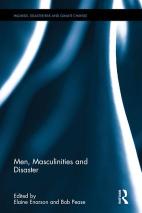Bring the hidden into view - Review of Men, masculinities and disaster by Elaine Enarson and Bob Pease

By Angelica Wågström, intern at GenderCC
My disaster is not the same as your disaster, even if it has the same name. Our different positions in a pre-disaster society not only affect our level of vulnerability, but also who of us will benefit from the disaster relief and who will be able to go back to employment post-disaster. For most of our readers these are not news, but what Men, Masculinities and Disaster achieves is showing this with concrete empirical research as well as discursive analyses of men and masculinities in eleven countries in different parts of the world.
Disasters can “bring the hidden into view”, as Elaine Enarson and Bob Pease put it in the introduction. Each chapter tells a different story, drawing on research based on a variety of methods in which men, but also women and (in one case) transgender people, speak up about their views on men, masculinity and disaster. Different voices give us examples of how existing gender regimes are changed or reinforced by disasters, and highlight the gendered inequalities that were already there in pre-disaster times, hidden behind the facade of what sometimes seem like a well functioning society.
What most stories have in common is a message of the harm that patriarchy brings not only to women, but to men and people of all genders: the same gender order that in many cases has made sexual abuse towards women and girls arise after natural disasters, also kills many men whose sense of masculine identity or male responsibility forbid them to evacuate when needed, and harm transgender persons who can be excluded from disaster relief or harassed in temporary shelters, to name a few of the examples raised in the book.
In the climate change discourse there is an awareness of vulnerability to climate change, especially of poor rural women in the global South. What several of the authors of this book do is shifting the focus from “empowering” women to instead suggesting that it is men who need to change their actions in order to give room to women’s participation. As Stephen Fisher writes, “working with men to address the gender dimensions of disaster risk management is very important”, since focusing on men can counter the “feminization of responsibility”. Similarly, Debra Parkinson and Claire Zara conclude their chapter by stating that while there is much focus in getting women to work, “it is critical (…) that men take on their share of domestic and caring labor before women are tasked with further work in disasters”.
Even though the book is dripping with horrifying stories of harms caused by expressions of a patriarchal worldview, there is still room for some positive examples. One of these is told by Kylah Genade, who describes how a South African men’s organization for gender equality by focusing on changing men’s attitudes helped them to take more responsibility of the household. Naturally, this gave women more time to engage in other activities, which in the long run could increase women’s participation in the public, reducing their vulnerability to disasters.
What I personally find interesting about the South African men’s organization is that it was a change in the division of labor that brought with it a reduction in vulnerability. This leads me to a statement by Bob Pease, meaning that the division of labor prior to a disaster assigns to several gendered differences in both responsibility for and vulnerability of climate change. As an example of this he mentions men’s higher use of business flights and cars, which could be explained not only by certain masculinities, but also in very material terms by a gendered division of labor. Also, many of the chapters address masculinities that are closely tied to specific professions, such as firefighting masculinities to which strength and risk-taking is specifically strong. Considering these links between labor and masculinity, I wonder if not research on masculinities and disaster could bring important knowledge to studies in (feminist) political economy and vice versa.
Some of the chapters show that masculinity is not only a trait to an individual, but also embedded in institutions and communities. What I would have wanted to see more of is a discussion of how these structures can be challenged and transformed on a large-scale level. Do we merely need to address the fact that disasters are gendered, creating awareness of the need to broaden ideas of acceptable behaviours of men and women, or do we also need material changes? As this book show, addressing masculinities is of high importance, but since gender norms are deeply interlinked with relations to production, masculinity studies can never be limited to an issue of identity and individual actions. “Shifts in individual identity are not enough”, as Raewyn Connell states in the afterword of the book, and I have to agree with her.
However, masculinity is in fact not only about gender; some of the authors draw intersections between masculinities and other social constructs such as race, age and ability, and argue for an intersectional lens on disaster research. Mark Sherry, for example, describes how sheltering, warnings and evacuation are most often inaccessible to disabled people, as in cases where warning systems are only in the form of sirens, leading to disproportionately high numbers of deaths among hearing impaired people. This shows how not only false assumptions about certain social categories, but especially invisibility of others, can lead to high vulnerability to disasters. This vulnerability cannot be counteracted unless the stereotyped are shown in all their differences and the invisible are made visible. For this purpose, Men, Masculinities and Disaster provides an extensive beginning of what hopefully will be much more research on these issues.
I suggest the book to be read by disaster relief workers and planners as well as anyone involved in environmental policy-making in order to understand what harm the ignorance of gender and norms of masculinity does to human beings, of all genders. For those active in the field of climate change, I believe this book can inspire to widen the gaze from so called “vulnerable women” to also look further into the role of masculinities, men and intersecting social constructs that decide our position in a changing environment.
Enarson, Elaine and Pease, Bob. 2016. Men, Masculinities and Disaster. Routledge, Abingdon. 246 pp.
